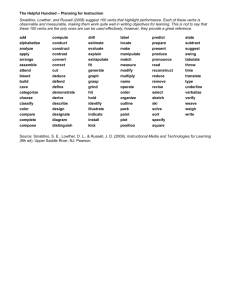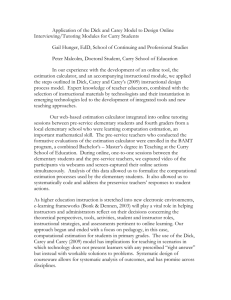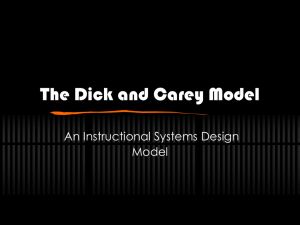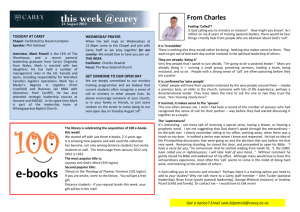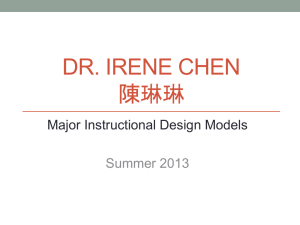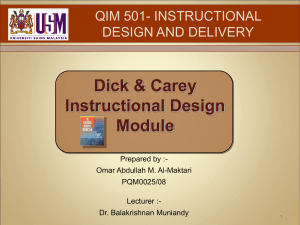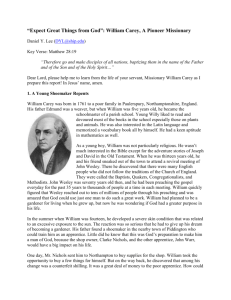Click here to view an example of a reflective writing.
advertisement
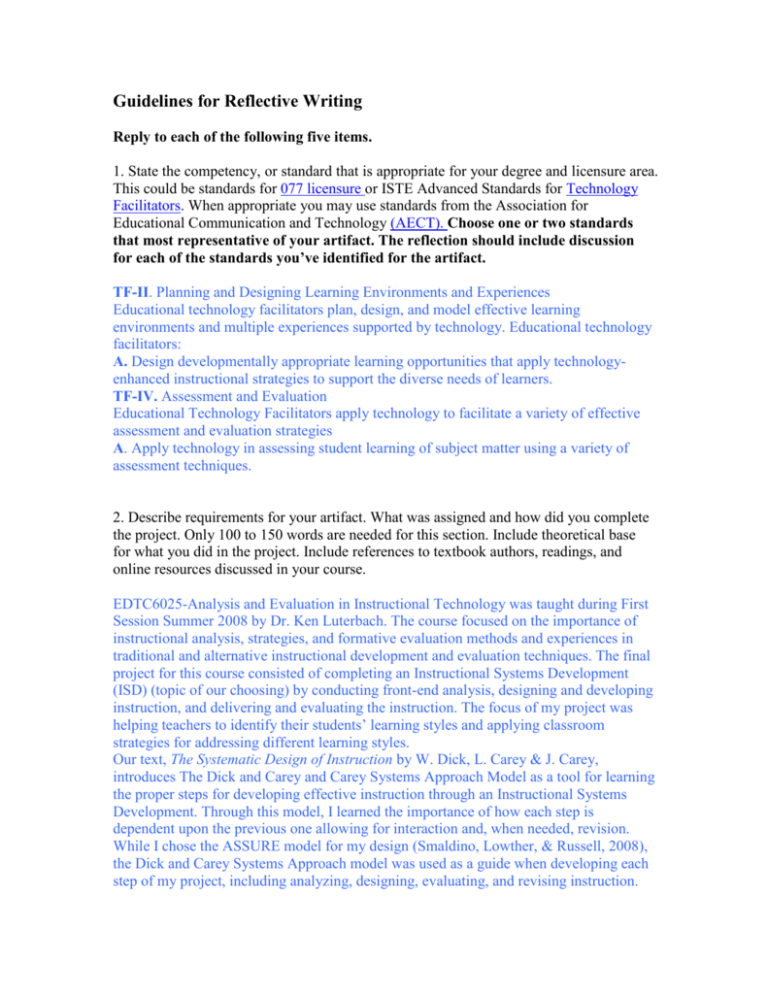
Guidelines for Reflective Writing Reply to each of the following five items. 1. State the competency, or standard that is appropriate for your degree and licensure area. This could be standards for 077 licensure or ISTE Advanced Standards for Technology Facilitators. When appropriate you may use standards from the Association for Educational Communication and Technology (AECT). Choose one or two standards that most representative of your artifact. The reflection should include discussion for each of the standards you’ve identified for the artifact. TF-II. Planning and Designing Learning Environments and Experiences Educational technology facilitators plan, design, and model effective learning environments and multiple experiences supported by technology. Educational technology facilitators: A. Design developmentally appropriate learning opportunities that apply technologyenhanced instructional strategies to support the diverse needs of learners. TF-IV. Assessment and Evaluation Educational Technology Facilitators apply technology to facilitate a variety of effective assessment and evaluation strategies A. Apply technology in assessing student learning of subject matter using a variety of assessment techniques. 2. Describe requirements for your artifact. What was assigned and how did you complete the project. Only 100 to 150 words are needed for this section. Include theoretical base for what you did in the project. Include references to textbook authors, readings, and online resources discussed in your course. EDTC6025-Analysis and Evaluation in Instructional Technology was taught during First Session Summer 2008 by Dr. Ken Luterbach. The course focused on the importance of instructional analysis, strategies, and formative evaluation methods and experiences in traditional and alternative instructional development and evaluation techniques. The final project for this course consisted of completing an Instructional Systems Development (ISD) (topic of our choosing) by conducting front-end analysis, designing and developing instruction, and delivering and evaluating the instruction. The focus of my project was helping teachers to identify their students’ learning styles and applying classroom strategies for addressing different learning styles. Our text, The Systematic Design of Instruction by W. Dick, L. Carey & J. Carey, introduces The Dick and Carey and Carey Systems Approach Model as a tool for learning the proper steps for developing effective instruction through an Instructional Systems Development. Through this model, I learned the importance of how each step is dependent upon the previous one allowing for interaction and, when needed, revision. While I chose the ASSURE model for my design (Smaldino, Lowther, & Russell, 2008), the Dick and Carey Systems Approach model was used as a guide when developing each step of my project, including analyzing, designing, evaluating, and revising instruction. 3. Explain how your artifact is a good example of the objective, competency, or standard. Defend your evidence as if you were a lawyer defending the validity of evidence submitted for the trial. Include references to theory in Instructional Design and Technology. Because TF-II (ISTE Standards) states that “Educational technology facilitators plan, design, and model effective learning environments and multiple experiences supported by technology,” I chose “Learning Styles” for my ASSURE lesson design (Smaldino, Lowther, & Russell, 2008) as a subject that is applicable and feasible to use in my school and utilized a variety of technologies to deliver this lesson (for example; moodle, PowerPoint, and iMovie). I exercised appropriate planning by conducting a front-end analysis was instrumental in helping to determine which teachers needed the instruction, what the learner did/did not know and what needed to be taught during the instruction. My instruction included motivational strategies by helping teachers to apply the instruction to their classroom with the goals of helping to reduce disruption and increase learning in their classroom. As Dick and Carey and Carey suggested (2005), technology and job aids were used during instruction to help promote interest and learner participation. Because TF-IV (ISTE Standards) states that “Educational Technology Facilitators apply technology to facilitate a variety of effective assessment and evaluation strategies,” the evaluation phase of my ISD included opportunities for adjustments and revisions as implemented in the Dick and Carey and Carey Systems model. 4 . Discuss how you might change the content, strategy, or design of the artifact. If you see no need for change, elaborate on the artifact is a good exemplar for the competency or standard. In deciding which ISD model to use for my project, I selected the ASSURE model (Smaldino, Lowther, & Russell, 2008) that closely resembles the methods I’m most comfortable with. By designing my instruction with this model, I’m confident that no changes are needed in my specific design of instruction as each step was carefully evaluated and implementation was small-group tested and peer-evaluated. However, in order to be more efficient, as well as more prepared for technological problems that arose during my instruction, I will test out the computer lab one day ahead of time to be sure that software necessary for my lesson is loaded on each computer. In addition I will be sure that all sound cards are working properly on the computers for my lesson. Keeping this in mind, I am well aware that reflection and evaluation are always an important part of an ISD and adjustments must be made as needed. 5. Discuss how the artifact is representative of future career goals and plans. This project and class taught me the importance of analyzing each step of the design due to the impact each step has on the next. Formative evaluations were conducted through peer-evaluation, questionnaires and a small group field trial ensuring a smooth and effective lesson. I feel better prepared to design instruction for my peers in my future work as a technology facilitator. In addition, I have come to understand the importance of reflection and evaluation as an on-going process during design and implementation as it helps me to ensure that instruction is current and effective and that learning is successful. My instruction during this lesson included modeling strategies that the teachers could use in their classroom. By implementing strategies during the lesson and helping teachers to create their own strategies for their diverse learners, this process has helped me to plan for instruction that will help me meet my goal of helping teachers to transfer these techniques to their own classrooms. My goals for future reference to this artifact therefore include using the ASSURE model (Smaldino, Lowther, & Russell, 2008) for future staff developments, with the Dick and Carey Systems as a basis for design. By applying the ASSURE model, I plan to model the proper procedures, strategies and technology for teachers to apply in their classroom. Whatever the subject, the ISD model will apply, creating effective instruction while leaving room for evaluation and revisions. I also plan to share my Learning Styles staff development with other schools in my district as it can be revised to accommodate all grade levels. References Dick, W., Carey, L., & Carey, J. (2005). The Systematic Design of Instruction (6th ed.). Boston, MA: Allyn and Bacon. Smaldino, S. E., Lowther, D. L., & Russell, J. D. (2008). Instructional Technology and Media for Learning (9th ed.). Columbus, OH: Pearson.
